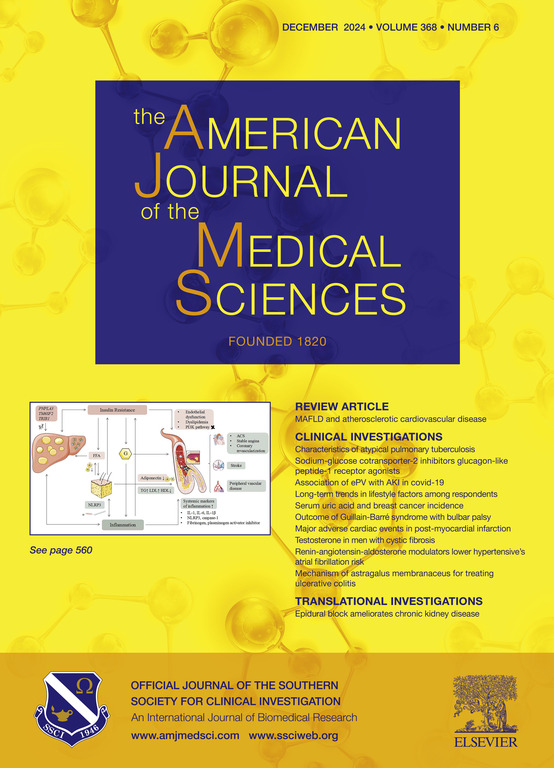Is 90 the new 80? Temporal trends in nonagenarians undergoing percutaneous coronary interventions
IF 2.3
4区 医学
Q2 MEDICINE, GENERAL & INTERNAL
引用次数: 0
Abstract
Background
Coronary artery disease (CAD) is a leading cause of death in the elderly population. Data regarding percutaneous coronary interventions (PCIs) in nonagenarians are scarce, and differences in long term outcomes between generations remain unclear. We aimed to study the pattern and temporal trends of nonagenarians treated with PCI. Materials and Methods: A total of 14,695 patients underwent PCI between 2009-2020. We identified 2,034 (13.8%) octogenarians (age 80-89), and 222 (1.5%) nonagenarians (age 90-99). Endpoints included mortality and major adverse cardiac events (MACE) at 1 year.
Materials and Methods
A total of 14,695 patients underwent PCI between 2009-2020. We identified 2,034 (13.8%) octogenarians (age 80-89), and 222 (1.5%) nonagenarians (age 90-99). Endpoints included mortality and major adverse cardiac events (MACE) at 1 year.
Results
The number of nonagenarians undergoing PCI has increased substantially during the study time period, from 89 patients in the earlier time period (2009-2014) to 133 patients in the later time period (2015-2020). At 1-year, nonagenarians had significantly higher rates of both death (24.3% vs. 14.9%, p<0.01), and MACE (30.6% vs. 22.0%, p<0.01), as compared to octogenarians. The cumulative survival rate was higher among octogenarians both in the early and late time period (p<0.01 and p=0.039, respectively). A significant reduction in nonagenarian MACE rates were observed during the study time period, resulting in a non-significant difference in MACE rates in the later time period between both groups.
Conclusion
The number of nonagenarians who undergo PCI is on the rise. While their clinical outcomes are inferior as compared to younger age groups, improvement was noted in the late time period.
90 岁是新的 80 岁吗?接受经皮冠状动脉介入治疗的非老年患者的时间趋势。
背景:冠状动脉疾病(CAD)是导致老年人死亡的主要原因。有关非老年人经皮冠状动脉介入治疗(PCI)的数据很少,不同年龄段之间的长期疗效差异仍不清楚。我们旨在研究接受 PCI 治疗的非老年患者的模式和时间趋势:2009-2020年间,共有14695名患者接受了PCI治疗。我们确定了 2034 名(13.8%)八旬老人(80-89 岁)和 222 名(1.5%)非耄耋老人(90-99 岁)。终点包括1年的死亡率和主要心脏不良事件(MACE):在研究期间,接受PCI治疗的非老年患者人数大幅增加,从早期(2009-2014年)的89人增加到后期(2015-2020年)的133人。1年后,非长者的死亡率明显高于长者(24.3% vs. 14.9%,pConclusion):接受PCI治疗的非长者人数正在增加。虽然他们的临床结果不如年轻群体,但在晚期有所改善。
本文章由计算机程序翻译,如有差异,请以英文原文为准。
求助全文
约1分钟内获得全文
求助全文
来源期刊
CiteScore
4.40
自引率
0.00%
发文量
303
审稿时长
1.5 months
期刊介绍:
The American Journal of The Medical Sciences (AJMS), founded in 1820, is the 2nd oldest medical journal in the United States. The AJMS is the official journal of the Southern Society for Clinical Investigation (SSCI). The SSCI is dedicated to the advancement of medical research and the exchange of knowledge, information and ideas. Its members are committed to mentoring future generations of medical investigators and promoting careers in academic medicine. The AJMS publishes, on a monthly basis, peer-reviewed articles in the field of internal medicine and its subspecialties, which include:
Original clinical and basic science investigations
Review articles
Online Images in the Medical Sciences
Special Features Include:
Patient-Centered Focused Reviews
History of Medicine
The Science of Medical Education.

 求助内容:
求助内容: 应助结果提醒方式:
应助结果提醒方式:


